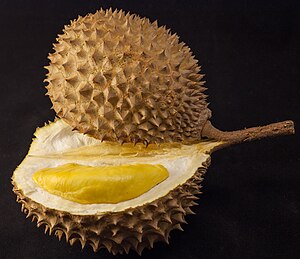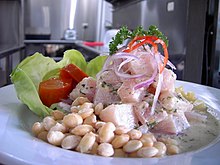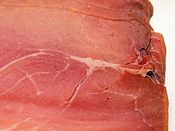Portal:Food
F o o d
A portal dedicated to food and foodways
Introduction


Food is any substance consumed by an organism for nutritional support. Food is usually of plant, animal, or fungal origin and contains essential nutrients such as carbohydrates, fats, proteins, vitamins, or minerals. The substance is ingested by an organism and assimilated by the organism's cells to provide energy, maintain life, or stimulate growth. Different species of animals have different feeding behaviours that satisfy the needs of their metabolisms and have evolved to fill a specific ecological niche within specific geographical contexts.
Omnivorous humans are highly adaptable and have adapted to obtaining food in many different ecosystems. Humans generally use cooking to prepare food for consumption. The majority of the food energy required is supplied by the industrial food industry, which produces food through intensive agriculture and distributes it through complex food processing and food distribution systems. This system of conventional agriculture relies heavily on fossil fuels, which means that the food and agricultural systems are one of the major contributors to climate change, accounting for as much as 37% of total greenhouse gas emissions. (Full article...)
Cooking, also known as cookery or professionally as the culinary arts, is the art, science and craft of using heat to make food more palatable, digestible, nutritious, or safe. Cooking techniques and ingredients vary widely, from grilling food over an open fire, to using electric stoves, to baking in various types of ovens, reflecting local conditions. Cooking is an aspect of all human societies and a cultural universal.
Preparing food with heat or fire is an activity unique to humans. Archeological evidence of cooking fires from at least 300,000 years ago exists, but some estimate that humans started cooking up to 2 million years ago.
The expansion of agriculture, commerce, trade, and transportation between civilizations in different regions offered cooks many new ingredients. New inventions and technologies, such as the invention of pottery for holding and boiling of water, expanded cooking techniques. Some modern cooks apply advanced scientific techniques to food preparation to further enhance the flavor of the dish served. (Full article...)
El Celler de Can Roca is a restaurant in Girona, Catalonia, Spain opened in 1986 by the Roca brothers, Joan, Josep and Jordi. It was first located next to their parents' restaurant Can Roca, but moved to its current purpose-built building in 2007. It has been received warmly by critics, and holds three Michelin stars. El Celler de Can Roca was ranked the best restaurant in the world by the magazine Restaurant in 2013 and 2015, and was ranked second in 2011, 2012, 2014, and 2018. (Full article...)
Selected article –
Ceviche, cebiche, sebiche, or seviche (Spanish pronunciation: [seˈβitʃe]) is a cold dish consisting of fish or shellfish marinated in citrus and seasonings. Different versions of ceviche are part of the culinary cultures of various Latin American countries along the Pacific Ocean where each one is native, including Chile, Colombia, Costa Rica, Ecuador, El Salvador, Guatemala, Honduras, Mexico, Nicaragua, Panama, and Peru. Ceviche is considered the national dish of Peru and is recognized by UNESCO as an expression of Peruvian traditional cuisine and an Intangible Cultural Heritage of Humanity.
The fish or shellfish in ceviche is served raw; the citric acid from the citrus marinade causes the proteins in the seafood to become denatured, resulting in the dish appearing to be "cooked" without the application of heat. The fish is typically cured in lemon or sour lime juice, although sour orange was historically used. The dressing also includes some local variety of chili pepper or chili, replaced by mustard in some parts of Central America. The marinade usually also includes sliced or chopped onions and chopped cilantro, though in some regions such as Mexico, tomatoes, avocadoes, and tomato sauce may be included. (Full article...)
Selected cuisine -

Historically, Korean cuisine has evolved through centuries of social and political change. Originating in ancient agricultural and nomadic traditions in southern Manchuria and the Korean Peninsula, it has gone through a complex interaction of the natural environment and different cultural trends. Rice dishes and kimchi are staple Korean foods. In a traditional meal, they accompany both side dishes (panch'an) and main courses like chuk (porridge), pulgogi (grilled meat) or myŏn (noodles). Soju liquor is the best-known traditional Korean spirit. (Full article...)
Selected ingredient –

The durian (/ˈdʊəriən/ ⓘ) is the edible fruit of several tree species belonging to the genus Durio. There are 30 recognized species, at least nine of which produce edible fruit. Durio zibethinus, native to Borneo and Sumatra, is the only species available on the international market. It has over 300 named varieties in Thailand and over 200 in Malaysia as of 2021. Other species are sold in their local regions.
Known in some regions as the "king of fruits", the durian is distinctive for its large size, strong odour, and thorn-covered rind. The fruit can grow as large as 30 cm (12 in) long and 15 cm (6 in) in diameter, and it typically weighs 1 to 3 kg (2 to 7 lb). Its shape ranges from oblong to round, the colour of its husk from green to brown, and its flesh from pale yellow to red, depending on the species. (Full article...)
Selected recipe –
Cornbread is a quick bread made with cornmeal, associated with the cuisine of the Southern United States, with origins in Native American cuisine. It is an example of batter bread. Dumplings and pancakes made with finely ground cornmeal are staple foods of the Hopi people in Arizona. The Hidatsa people of the Upper Midwest call baked cornbread naktsi, while the Choctaw people of the Southeast call it bvnaha. The Cherokee and Seneca tribes enrich the basic batter, adding chestnuts, sunflower seeds, apples, or berries, and sometimes combine it with beans or potatoes. Modern versions of cornbread are usually leavened by baking powder. (Full article...)
Sweet Cornbread is a variant of the Skillet Cornbread made throughout the Southern United States.
Boletus edulis (English: cep, penny bun, porcino or porcini) is a basidiomycete fungus, and the type species of the genus Boletus.
Prized as an ingredient in various culinary dishes, B. edulis is an edible mushroom held in high regard in many cuisines, and is commonly prepared and eaten in soups, pasta, or risotto. The mushroom is low in fat and digestible carbohydrates, and high in protein, vitamins, minerals and dietary fibre. Although it is sold commercially, it is very difficult to cultivate. Available fresh in autumn throughout Europe and Russia, it is most often dried, packaged, and distributed worldwide. It keeps its flavour after drying, and it is then reconstituted and used in cooking. B. edulis is also one of the few fungi sold pickled. (Full article...)
Selected image –

Selected biography –

B. June 25, 1956 – d. June 8, 2018
Anthony Michael Bourdain (/bɔːrˈdeɪn/ bor-DAYN; June 25, 1956 – June 8, 2018) was an American celebrity chef, author, and travel documentarian. He starred in programs focusing on the exploration of international culture, cuisine, and the human condition.
Bourdain was a 1978 graduate of the Culinary Institute of America and a veteran of many professional kitchens during his career, which included several years spent as an executive chef at Brasserie Les Halles in Manhattan. In the late 1990s Bourdain wrote an essay about the ugly secrets of a Manhattan restaurant, but he was having difficulty getting it published. According to the New York Times, his mother Gladys—then an editor and writer at the paper—handed her son's essay to friend and fellow editor Esther B. Fein, the wife of David Remnick, editor of the magazine The New Yorker. Remnick ran Bourdain's essay in the magazine, kickstarting Bourdain's career and legitimizing the point-blank tone that would become his trademark. The success of the article was followed just a year later by the publication of a New York Times best-selling book, Kitchen Confidential: Adventures in the Culinary Underbelly (2000). (Full article...)
Did you know (auto-generated) –

- ... that Binggrae, a South Korean food and beverage company, was the official ice cream supplier of the 1988 Seoul Olympics?
- ... that food critic Grace Dent reviewed a Liverpool restaurant that served her rice pudding flavoured with a substance that is banned in the United States for its lethality?
- ... that food stylist Susan Spungen estimated that she baked hundreds of pies with Josh Brolin and film staff while practicing for a scene in Labor Day?
- ... that environmental activist Nigel Savage created Hazon after googling "Jewish food movement" and receiving zero search results?
- ... that the Kitāb al-ṭabīẖ, a medieval Andalusian cookbook, contains an early version of Jewish challah bread, which traveled with Jews expelled from Spain and likely influenced Ashkenazi cuisine?
- ... that by 1967, staff at the Home Office were told not to feed Peta morsels of food as she had become "inordinately fat"?
More did you know –
Related portals
Food topics
The following are topics relating to food
Categories
Food list articles
- See also: Lists of foods and Category:Lists of drinks
The following are some Food list articles on Wikipedia:

- American cheeses
- Appellation d'Origine Contrôlée cheeses
- Apple cultivars
- Bacon dishes
- Bacon substitutes
- Basil cultivars
- Breads
- Breakfast beverages
- Breakfast cereals
- Breakfast foods
- British cheeses
- Cakes
- Candies
- Cheeses
- Cheese soups
- Christmas dishes (list)
- Cocktails
- Cookies
- Dishes using coconut milk
- Diets
- Doughnut varieties
- Egg dishes
- Fermented soy products
- Food additives
- Food additives (Codex Alimentarius)
- Foods named after people
- French cheeses
- French dishes
- Fried dough foods
- Fruits
- List of hamburgers
- Herbs and spices
- Hors d'oeuvre
- Indian dishes
- Indian snack foods
- Indonesian dishes
- Italian dishes
- Japanese snacks
- Japanese dishes
- Jewish dishes
- Kebabs
- Korean beverages
- Mango cultivars
- Moroccan dishes
- Pasta
- Pastries
- Philippine snack food
- Pies, tarts and flans
- Poppy seed pastries and dishes
- Potato dishes
- Puddings
- Raw fish dishes
- Rice dishes
- Rolled foods
- Sauces
- Seafood
- Seeds
- Sandwiches
- Snack foods
- Soft drinks by country
- Soul foods and dishes
- Soups
- Stews
- Street foods
- Tapas
- Turkish dishes
- Twice-baked foods
- Vegetable oils
- Vegetables
- Vodkas
Things you can do
Related WikiProjects
| Parent project: WikiProject Food and Drink | |
| Child projects: | Task forces: (All inactive) |
|
|
| Related projects: | |
New articles
Rules | Match log | Results page (for watching) | Last updated: 2025-02-16 19:16 (UTC)
Note: The list display can now be customized by each user. See List display personalization for details.
- P'Zone (edit | talk | history | links | watch | logs | tools) by Howardcorn33 (talk · contribs · new pages (44)) started on 2025-02-16, score: 10
- Waiau Lodge Hotel (edit | talk | history | links | watch | logs | tools) by Panamitsu (talk · contribs · new pages (19)) started on 2025-02-13, score: 10
- Chek ktis (edit | talk | history | links | watch | logs | tools) by Turaids (talk · contribs · new pages (5)) started on 2025-02-15, score: 10
- Vincenzo Buonassisi (edit | talk | history | links | watch | logs | tools) by Horse Eye's Back (talk · contribs · new pages (87)) started on 2025-02-14, score: 10
- Lattanzi Cucina Italiana (edit | talk | history | links | watch | logs | tools) by Eric Carpenter (talk · contribs · new pages (14)) started on 2025-02-14, score: 10
- Neltuma nigra (edit | talk | history | links | watch | logs | tools) by Jts1882 (talk · contribs · new pages (15)) started on 2025-02-13, score: 10
- Pedana kalamkari (edit | talk | history | links | watch | logs | tools) by Hemant Dabral (talk · contribs · new pages (53)) started on 2025-02-13, score: 10
- Murder of Kim Ha-neul (edit | talk | history | links | watch | logs | tools) by NelsonLee20042020 (talk · contribs · new pages (20)) started on 2025-02-12, score: 10
- Walter E. Baethgen (edit | talk | history | links | watch | logs | tools) by Devonian Wombat (talk · contribs · new pages (8)) started on 2025-02-11, score: 10
- 2025 Ride the 'Dente 200 (edit | talk | history | links | watch | logs | tools) by Brycenrichter (talk · contribs · new pages (10)) started on 2025-02-05, score: 10
- Dairy shop (edit | talk | history | links | watch | logs | tools) by Lambiam (talk · contribs · new pages (11)) started on 2025-02-11, score: 20
- Henry IV Seizing the Opportunity to Conclude Peace (edit | talk | history | links | watch | logs | tools) by MaybeItsBecauseImALondoner (talk · contribs · new pages (69)) started on 2025-02-10, score: 10
- Covered Bridge (company) (edit | talk | history | links | watch | logs | tools) by Clovermoss (talk · contribs · new pages (32)) started on 2025-02-04, score: 10
- Cooking of apples (edit | talk | history | links | watch | logs | tools) by Mrfoogles (talk · contribs · new pages (5)) started on 2025-02-10, score: 20
- Becky Selengut (edit | talk | history | links | watch | logs | tools) by Jill Siggy (talk · contribs · new pages (1)) started on 2025-02-09, score: 10
- Alice Ross (edit | talk | history | links | watch | logs | tools) by CzarJobKhaya (talk · contribs · new pages (1)) started on 2025-02-09, score: 10
- Paniel Meat Processing (edit | talk | history | links | watch | logs | tools) by 24eeWikiUser (talk · contribs · new pages (4)) started on 2025-02-09, score: 10
- Cucumber salad (edit | talk | history | links | watch | logs | tools) by Shirt58 (talk · contribs · new pages (3)) started on 2025-02-09, score: 10
- Ed Cordero (edit | talk | history | links | watch | logs | tools) by YssaLang (talk · contribs · new pages (9)) started on 2025-02-09, score: 10
- Cocoa bean fermentation (edit | talk | history | links | watch | logs | tools) by Rollinginhisgrave (talk · contribs · new pages (6)) started on 2025-02-09, score: 20
- Dek Akeo (edit | talk | history | links | watch | logs | tools) by Emma Oruk (talk · contribs · new pages (5)) started on 2025-02-08, score: 10
- Dill pickle chip (edit | talk | history | links | watch | logs | tools) by Clovermoss (talk · contribs · new pages (32)) started on 2025-02-04, score: 20
- Favour Fawunmi (edit | talk | history | links | watch | logs | tools) by Hildreth gazzard (talk · contribs · new pages (164)) started on 2025-02-08, score: 10
- Speed (energy drink) (edit | talk | history | links | watch | logs | tools) by AlviRMahi (talk · contribs · new pages (3)) started on 2025-02-05, score: 20
- 200 Proven Recipes for Dishes, Pastries and Other Household Works (edit | talk | history | links | watch | logs | tools) by Iurii.s (talk · contribs · new pages (1)) started on 2025-02-05, score: 10
- Salt and vinegar chip (edit | talk | history | links | watch | logs | tools) by Clovermoss (talk · contribs · new pages (32)) started on 2025-02-04, score: 30
- Culmination Brewing (edit | talk | history | links | watch | logs | tools) by Another Believer (talk · contribs · new pages (91)) started on 2025-02-07, score: 10
- 2025 Chili's Ride the 'Dente 200 (edit | talk | history | links | watch | logs | tools) by Brycenrichter (talk · contribs · new pages (10)) started on 2025-02-05, score: 10
- Maryam's Bread (edit | talk | history | links | watch | logs | tools) by Ahmed (talk · contribs · new pages (1)) started on 2025-02-05, score: 10
- Angie O'Steen (edit | talk | history | links | watch | logs | tools) by Moondragon21 (talk · contribs · new pages (140)) started on 2025-02-05, score: 10
- True Fruits (edit | talk | history | links | watch | logs | tools) by Snowyday99 (talk · contribs · new pages (1)) started on 2025-02-05, score: 10
- Spaghett (edit | talk | history | links | watch | logs | tools) by BanjoZebra (talk · contribs · new pages (7)) started on 2025-02-04, score: 40
- Dianaruthe Wharton (edit | talk | history | links | watch | logs | tools) by Miraclepine (talk · contribs · new pages (17)) started on 2025-02-01, score: 10
- Nagqu Horse Racing Festival (edit | talk | history | links | watch | logs | tools) by TinaLees-Jones (talk · contribs · new pages (134)) started on 2025-02-04, score: 20
- Yalong Cultural Tourism Festival (edit | talk | history | links | watch | logs | tools) by TinaLees-Jones (talk · contribs · new pages (134)) started on 2025-02-04, score: 20
- Mount Qomolangma Cultural Tourism Festival (edit | talk | history | links | watch | logs | tools) by TinaLees-Jones (talk · contribs · new pages (134)) started on 2025-02-04, score: 20
- Powdered cheese (edit | talk | history | links | watch | logs | tools) by Mooonswimmer (talk · contribs · new pages (6)) started on 2025-02-03, score: 30
- Foodtastic (edit | talk | history | links | watch | logs | tools) by Mystic eye (talk · contribs · new pages (1)) started on 2025-02-03, score: 20
- Lee Hu Cake Shop (edit | talk | history | links | watch | logs | tools) by Heeheemalu (talk · contribs · new pages (6)) started on 2025-02-03, score: 20
- Bulgarini Vino Cucina (edit | talk | history | links | watch | logs | tools) by Sky Harbor (talk · contribs · new pages (6)) started on 2025-02-02, score: 10
- Vittorio's (edit | talk | history | links | watch | logs | tools) by ShticktatorTal (talk · contribs · new pages (1)) started on 2025-02-02, score: 10
- Henri Babinski (edit | talk | history | links | watch | logs | tools) by Tim riley (talk · contribs · new pages (2)) started on 2025-02-02, score: 10
- Nangnang Fish (edit | talk | history | links | watch | logs | tools) by Emma Oruk (talk · contribs · new pages (5)) started on 2025-02-02, score: 20
- Raw Egg Nationalist (edit | talk | history | links | watch | logs | tools) by PARAKANYAA (talk · contribs · new pages (72)) started on 2025-02-01, score: 10
- Marusan-Ai (edit | talk | history | links | watch | logs | tools) by Labratscientist (talk · contribs · new pages (19)) started on 2025-02-02, score: 20
- Empire Christmas pudding (edit | talk | history | links | watch | logs | tools) by Valereee (talk · contribs · new pages (7)) started on 2025-02-01, score: 40
- 2024 Cocoa crisis (edit | talk | history | links | watch | logs | tools) by Rollinginhisgrave (talk · contribs · new pages (6)) started on 2025-01-30, score: 10
Associated Wikimedia
The following Wikimedia Foundation sister projects provide more on this subject:
-
Commons
Free media repository -
Wikibooks
Free textbooks and manuals -
Wikidata
Free knowledge base -
Wikinews
Free-content news -
Wikiquote
Collection of quotations -
Wikisource
Free-content library -
Wikiversity
Free learning tools -
Wiktionary
Dictionary and thesaurus
















































